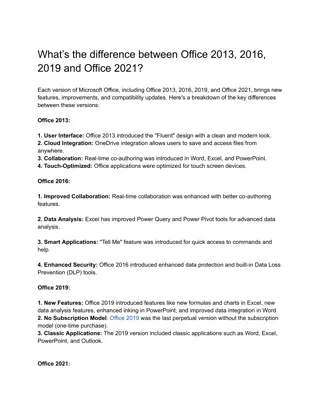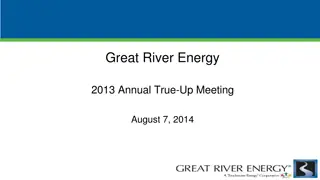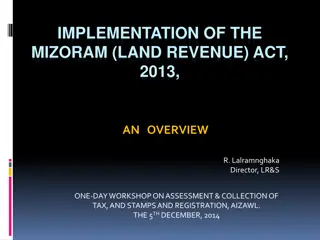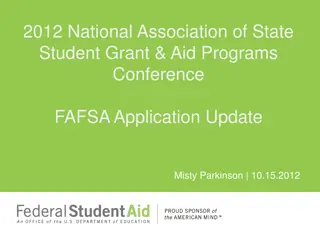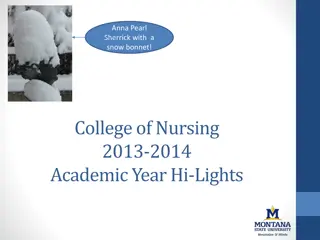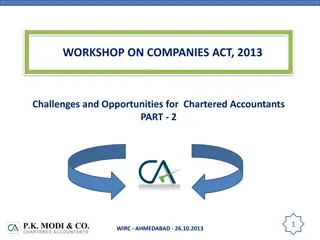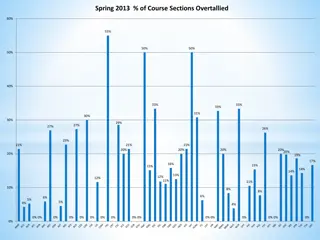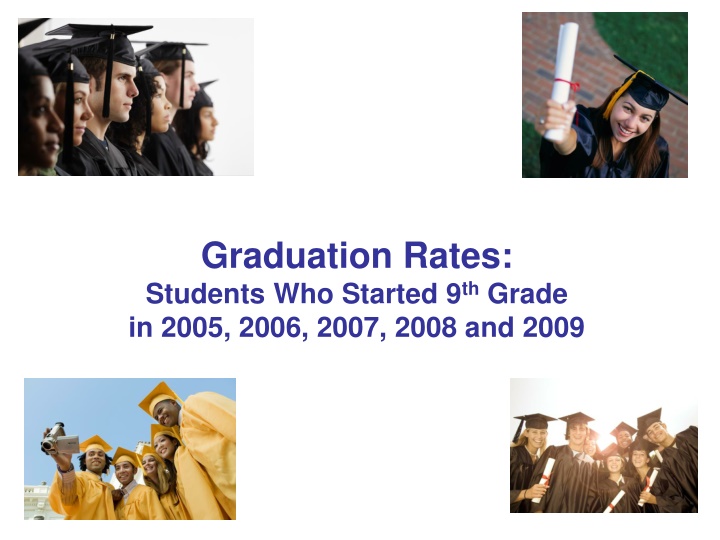
High School Graduation and College Readiness Trends
Explore the trends in high school graduation rates and college readiness for students who started 9th grade between 2005 and 2009. Discover the advancements made in academic preparedness and career pathways as part of educational reform initiatives, aiming to ensure all students are equipped for success in college and careers.
Download Presentation

Please find below an Image/Link to download the presentation.
The content on the website is provided AS IS for your information and personal use only. It may not be sold, licensed, or shared on other websites without obtaining consent from the author. If you encounter any issues during the download, it is possible that the publisher has removed the file from their server.
You are allowed to download the files provided on this website for personal or commercial use, subject to the condition that they are used lawfully. All files are the property of their respective owners.
The content on the website is provided AS IS for your information and personal use only. It may not be sold, licensed, or shared on other websites without obtaining consent from the author.
E N D
Presentation Transcript
Graduation Rates: Students Who Started 9th Grade in 2005, 2006, 2007, 2008 and 2009 1
High School Completion Most students who entered Grade 9 in 2008 or later did not have a local diploma option for graduation. Despite these higher expectations, the statewide graduation rate increased again slightly for the 2009 cohort. The graduation rate for the 2009 cohort (74.9%) is about nine percentage points higher than it was for the 2001 cohort (65.8%), which means that about 20,000 more students graduated in June 2013 than in June 2005. 2 2
Domains of College and Career Readiness Defines the academic knowledge and skills students need to be successful in college and careers. Specifies the non- cognitive, socio-emotional knowledge and skills that help students successfully transition from high school to college or careers. Describes the career- specific opportunities for students to gain the knowledge, skills, and competencies they need to pursue and succeed in their chosen career. 3 3
Academic Readiness for College and Careers Too few students exit their fourth year of high school with academic readiness for college or the workforce. This is true, regardless of the definition of Academic Readiness: The percent of students who graduate with higher scores on the English and a math Regents Exam: 37% of the 2009 cohort, or The percent of students who graduate and complete the more rigorous and comprehensive coursework required for the Advanced Designation diploma: 31% of the 2009 cohort. 4 4
Academic Readiness for College and Careers (cont d) To earn an Advanced Designation diploma, a student must complete additional coursework in a language other than English (LOTE) or Career and Technical Education (CTE) or the Arts and pass two additional Regents Exams in math and one additional Regents Exam in science. The percentage of students who complete the Advanced Designation diploma has remained relatively flat over the years. Large achievement gaps remain, particularly on the Advanced Designation diploma. 5 5
The Path Forward The Board of Regents continues to advance an educational reform agenda with the goal of ensuring that all students are college and career ready. The graduation rates announced today, covering the cohort of students who entered Grade 9 in 2009, do not yet fully reflect the impact that the Regents reform agenda will have on student outcomes. 6 6
The Path Forward (contd) Critical aspects of the reform agenda that are expected to prepare students for college and careers include: Implementing Common Core standards, curriculum and instruction aligned to the standards, and statewide assessments that measure student progress on the standards; Supporting instructional data systems that display student achievement and help teachers and principals improve their practice; Recruiting, developing, retaining, and rewarding effective teachers and principals; Turning around the lowest-achieving schools. 7 7
Graduation rates reported statewide and for Big 5 Districts as of June 2013 have generally increased slightly for the 2009 cohort. Percentage of Students Graduating with a Local, Regents, or Regents with Advanced Designation Diploma After 4 Years Results Through June, All Students 74.9% 74.0% 74.0% 73.4% 71.8% 66.4% 66.2% 66.0% 63.2% 61.3% 61.0% 60.9% 60.4% 59.0% 58.1% 54.0% 53.4% 53.1% 52.4% 52.8% 50.0% 49.0% 48.8% 48.4% 48.2% 48.0% 47.4% 46.8% 46.1% 45.9% 45.5% 45.2% 43.4% 43.0% 42.1% New York City Buffalo CSD Rochester CSD Syracuse CSD Yonkers CSD Large City N/RC* Total Public 2005 Cohort 2006 Cohort 2007 Cohort 2008 Cohort 2009 Cohort * Large City N/RC = Buffalo, Rochester, Syracuse, and Yonkers combined. 8 8 8
Graduation rates reported statewide and for Big 5 Districts as of August 2013 have generally increased slightly for the 2009 cohort. Percentage of Students Graduating with a Local, Regents, or Regents with Advanced Designation Diploma After 4 Years Results Through August, All Students 77.8% 76.8% 76.7% 76.1% 74.4% 72.3% 72.1% 72.1% 68.3% 66.0% 65.5% 65.1% 64.7% 62.7% 62.9% 57.3% 56.6% 56.0% 56.3% 55.3% 53.5% 53.0% 52.7% 52.2% 51.9% 51.1% 50.7% 50.5% 49.6% 49.0% 49.1% 48.6% 48.1% 47.8% 45.6% New York City Buffalo CSD Rochester CSD Syracuse CSD Yonkers CSD Large City N/RC* Total Public 2005 Cohort/August 2006 Cohort/August 2007 Cohort/August 2008 Cohort/August 2009 Cohort/August 9 9 9 * Large City N/RC = Buffalo, Rochester, Syracuse, and Yonkers combined.
Graduation rates for high need urban/suburban and rural districts have increased over the past five years. Average and low need districts have the highest graduation rates. Percentage of Students Graduating with a Local, Regents, or Regents with Advanced Designation Diploma After 4 Years Results Through June All Students 94.1% 93.9% 93.5% 93.3% 92.1% 85.7% 84.8% 84.4% 83.0% 81.0% 79.2% 77.4% 76.1% 75.4% 74.9% 74.2% 74.0% 74.0% 73.4% 71.8% 65.9% 65.1% 64.5% 64.5% 63.0% Urban-Suburban Rural Average Low Total Public 10 10 10 2005 Cohort 2006 Cohort 2007 Cohort 2008 Cohort 2009 Cohort
The Graduation Rate for Charter Schools Percentage of Students Graduating with a Local, Regents, or Regents with Advanced Designation Diploma After 4 Years Cohort Membership Results Through June, All Students 2005 807 2006 1,011 2007 1,115 2008 1,628 2009 2,215 70.1% 64.7% 57.2% 56.0% 47.2% Charters 2005 Cohort 2006 Cohort 2007 Cohort 2008 Cohort 2009 Cohort 11 11 11
The statewide percentage of students earning Local Diplomas has decreased. The percentage of students earning Regents Diplomas with Advanced Designation remains relatively flat. Statewide, the Percentage of Cohort Members Earning a Local, Regents, or Regents with Advanced Designation Diploma 80.9% 81.4% 80.0% 79.9% 79.7% 79.2% 78.3% 74.9% Cohort Membership 74.0% 74.0% 71.8%73.4% 2005 224,822 31% 31% 30% 2006 224,744 31% 30% 31% 30% 31% 30% 31% 31% 2007 223,285 30% 2008 221,366 2009 218,469 The cohort graduation rate is presented at the top of the columns. The overall rate may not equal the sum of each diploma type due to rounding. 35% 37% 34% 40% 36% 39% 45% 31% 33% 36% 41% 41% 15% 14% 13% 12% 10% 10% 10% 9% 7% 5% 4% 4% 2005 2006 2007 2005 2006 2007 2008 2009 2005 2006 2007 2008 Five Years Four Years Six Years 12 12 Local Diploma Regents Diploma Regents Diploma with Advanced Designation
The four-year graduation rate for New York City has increased slightly. A decreasing percentage of students earned a Local Diploma. The Percentage of Cohort Members Earning a Local, Regents, or Regents with Advanced Designation Diploma 73.2% 73.0% 70.9% 70.2% 69.5% 69.4% 67.8% Cohort Membership 17% 17% 61.3% 59.0%61.0% 60.9% 60.4% 16% 17% 17% 17% 16% 2005 77,378 2006 78,346 16% 17% 16% 17% 16% 2007 79,476 2008 79,719 33% 38% 2009 78,721 32% 43% 36% 42% 28% 49% 33% 37% The cohort graduation rate is presented at the top of the columns. The overall rate may not equal the sum of each diploma type due to rounding. 41% 41% 22% 20% 19% 16% 14% 14% 12% 12% 8% 4% 3% 3% 2005 2006 2007 2008 2009 2005 2006 2007 2008 2005 2006 2007 Four Years Five Years Six Years 13 13 Local Diploma Regents Diploma Regents Diploma with Advanced Designation
The Achievement Gap Persists The graduation rate achievement gap across racial/ethnic groups remains relatively stable. The gap is widest for the Advanced Designation diploma. Differences are decreasing between the cohort percentages of Black or Hispanic and White students earning Local Diplomas. Achievement gaps exist between females and males across all racial/ethnic groups. 14
Statewide, the graduation rate achievement gap has remained relatively stable. The gap is largest based on the percent of the cohort that earned a Regents Diploma with Advanced Designation. Differences are decreasing between the cohort percentages of Black or Hispanic and White students earning Local Diplomas. Statewide percentage of cohort members by diploma type after 4 years 86.5% 85.1% 85.7% 43% 42% 43% 58.4% 58.0% 58.1% 57.8% 59.7% 59.2% 9% 10% 9% 12% 12% 12% 39% 37% 46% 45% 43% 42% 36% 40% 39% 10% 9% 6% 4% 4% 4% 4% 3% 3% Black Hispanic White Black Hispanic White Black Hispanic White 2007 2008 2009 15 15 Local Diploma Regents Diploma Regents Diploma with Advanced Designation The cohort graduation rate is presented at the top of each column. The overall rate may not equal the sum of each diploma type due to rounding.
Statewide, the achievement gap exists between females and males across all racial/ethnic groups. Percentage of Students in 2009 Total Cohort Graduating with Regents or Local Diploma After Four Years Through June 2013 89% 87% 85% 84% 81% 79% 77% 75% 71% 68% 65% 64% 62% 60% 59% 57% 55% 54% American Indian / Alaska Native Asian Black Hispanic White All Racial/Ethnic Groups 16 16 Females Males Females and Males Combined
Race/ethnicity and gender achievement gaps exist across the Big 5 Districts. Percentage of Students in 2009 Total Cohort Graduating with Regents or Local Diploma After Four Years Through June 2013 83% 81% 74% 73% 72% 69% 66% 64% 62% 61% 60% 59% 58% 55% 55% 54% 53% 50% 49% 48% 47% 47% 46% 45% 44% 42% 42% 38% 37% 32% B H W B H W B R o c h e s t e r H W B H W B H W N Y C B u f f a l o Y o n k e r s S y r a c u s e 17 17 Females Males B = Black Students, H = Hispanic Students, W = White Students
Race/ethnicity and gender achievement gaps exist across remaining Need/Resource Groups. Percentage of Students in 2009 Total Cohort Graduating with Regents or Local Diploma After Four Years Through June 2013 97% 94% 91% 90% 90% 85% 85% 84% 83% 80% 78% 78% 77% 77% 72% 70% 70% 69% 67% 66% 66% 61% 61% 57% 56% 56% 55% 55% 50% 42% B H W B H W B H W B H W B H W L a r g e C i t i e s U r b a n / S u b u r b a n R u r a l A v e r a g e N e e d L o w N e e d 18 18 Females Males B = Black Students, H = Hispanic Students, W = White Students
English Language Learners The graduation rates for English Language Learners have generally decreased. The percentage of English Language Learners earning the Regents Diploma after four years has not increased sufficiently to offset the decrease in those earning the Local Diploma. However, the graduation rate for students who exited and no longer receive English Language Learner services is comparable to the general population. 19
The graduation rates for English Language Learners have generally decreased. Percentage of English Language Learner Students Graduating with Regents or Local Diploma as of June of Year 4 55.8% 53.5% 52% 47.7% 45.2% 41.5% 40.3% 40.3% 39.4% 38.8% 38.6% 38.2% 40% 36.9% 35.4% 39% 35.0% 35.2% 34.4% 34.5% 34.3% 32.3% 35% 35% 31.4% 30.4% 28.9% 26.8% 30% 30% 26.2% 24.3% 23.9% 21.6% 20.7% New York City Large City Urban- Suburban Rural Average Low Total Public 20 20 2005 Cohort 2006 Cohort 2007 Cohort 2008 Cohort 2009 Cohort
The percentage of English Language Learners earning the Regents Diploma after four years has not increased sufficiently to offset the decrease in those earning the Local Diploma. The percentage of English Language Learner cohort members earning a Local, Regents or Regents with Advanced Designation Diploma 56.7% 55.5% 55.2% 51.7% 51.7% 51.6% 7% 6% 7% 7% 6% 45.8% 7% Cohort Membership 6% 40.3% 38.6% 38.2% 21% 34.3% 6% 26% 2005 11,265 20% 6% 5% 31% 31.4% 24% 2006 11,635 6% 29% 2007 12,236 6% 2008 11,986 16% 20% 34% 23% 2009 12,277 25% 23% 28% 26% 24% 21% 19% 17% 17% 14% 10% 6% 4% 3% 2005 2006 Four Years 2007 2008 2009 2005 2006 Five Years 2007 2008 2005 2006 2007 Six Years 21 21 Local Diploma Regents Diploma Regents Diploma with Advanced Designation
However, the graduation rate for students who exited and no longer receive English Language Learner services is comparable to the general population. Results Through June 2013 After 4 Years Current ELL includes students who were identified as ELL during the school year of their last enrollment . 78% 75% 71% One-Time ELL includes students identified as ELL in any school year preceding the school year of their last enrollment (excludes students who are Current ELLs).* Never ELL includes students who were never reported to receive ELL services.* 31% 2009 Graduation Rate Current ELLs One-Time ELL (Excluding Current ELLs) Never ELL All Students 22 22 22 * Data are available for the 2005-06 to 2012-13 school years only. Therefore, students who received ELL services prior to grade 5 (prior to 2005-06 for students in grade 12 in the 2012-13 school year) will not be identified as One-Time ELL.
2009 Cohort Outcomes on Two Aspirational Performance Measures (APMs) are Reported for all Districts and High Schools. 1. Advanced Regents Diploma Percentage APM The percentage of cohort students who earned a Regents Diploma with Advanced Designation (22 units of credit, 7-9 Regents examinations at 65 or above, and advanced course sequences in languages other than English, CTE, or the arts). 2. ELA/Math APM The percentage of cohort students who graduated with a Local, Regents, or Regents with Advanced Designation diploma and earned a 75 or greater on their English Regents examination and earned a 80 or greater on a math Regents examination. Outcomes on APMs are significantly lower than the overall graduation rates. We will report APMs for schools and districts while college and career-ready graduation requirements are phased in for students. 23 23
Aspirational Performance Measures - Usage NYSED will update these APMs as new research findings become available and as Regents Exams begin to measure the Common Core Learning Standards. Although the ELA/Math APM remains a useful within-year comparison against performance benchmarks and across schools and districts, this measure is not directly comparable across cohorts, in part because of the different math Regents exams that were introduced and retired during the 2007-08 to 2009-10 school years. 24
Aspirational Performance Measures (APMs) as a Percentage of the Cohort Compared to Graduation Rate in the Big 5 School Districts 74.9% 74.0% All Students After 4 Years 66.4% 66.0% 61.3% Results Through June 60.4% 53.4% 48.8% 48.0% 46.8% 43.4% 43.0% 37.2% 35.3% 30.6% 29.9% 24.4% 22.8% 21.9% 17.0% 16.5% 11.7% 9.7% 9.7% 8.9% 7.4% 7.2% 7.0% 7.1% 6.6% 6.2% 6.1% 5.9% 5.8% 5.6% 5.1% New York City Buffalo Rochester Syracuse Yonkers Total Public 2008 Graduation Rate 2008 Regents with Adv Designation 2008 ELA/Math APM 2009 Graduation Rate 2009 Regents with Adv Designation 2009 ELA/Math APM 25 25 25
Aspirational Performance Measures (APMs) as a Percentage of the Cohort Compared to Graduation Rate for Charter Schools Cohort Membership Charter Schools Results Through June After 4 Years 2008 2009 1,628 2,215 74.9% 74.0% 70.1% 64.7% 37.2% 35.3% 30.6% 29.9% 20.2% 12.7% 12.2% 7.9% Charter Schools 2008 Graduation Rate 2008 Regents with Adv Designation 2008 ELA/Math APM All Public Schools 2009 Graduation Rate 2009 Regents with Adv Designation 2009 ELA/Math APM 26 26 26
Aspirational Performance Measures (APMs) as a Percentage of the Cohort Compared to Graduation Rate by Race/Ethnicity Students in Public Schools After 4 Years Results Through June 86.5% 85.7% 81.6% 80.6% 74.9% 74.0% 62.2% 59.7% 59.2% 58.5% 58.1% 57.8% 57.2% 56.5% 49.8% 50.4% 49.4% 48.5% 43.3% 42.3% 37.2% 35.3% 30.6% 29.9% 21.3% 18.8% 18.0% 16.5% 15.7% 14.2% 12.6% 12.5% 12.4% 12.1% 9.4% 9.0% American Indian/Alaska Native Black Hispanic Asian White All Students 2008 Graduation Rate 2008 Regents with Adv Designation 2008 ELA/Math APM 2009 Graduation Rate 2009 Regents with Adv Designation 2009 ELA/Math APM 27 27 27
Aspirational Performance Measures (APMs) as a Percentage of the Cohort Compared to Graduation Rate Students in Public Schools After 4 Years One-Time ELL includes students identified as ELL in any school year preceding the school year of their last enrollment. (excludes students who are Current ELLs).* Results Through June 79.3% 79.2% 74.9% 74.0% 71.0% 48.7% 44.7% 42.4% 40.8% 37.2% 35.3% 35.1% 34.7% 34.3% 31.4% 30.6% 29.9% 23.2% 18.4% 7.3% 5.9% 5.6% 5.5% 5.4% 4.9% 3.1% 3.0% English Language Learners One-Time ELL* Students with Disabilities General Education Students 2009 Graduation Rate 2009 Regents with Adv Designation 2009 ELA/Math APM All Students 2008 Graduation Rate 2008 Regents with Adv Designation 2008 ELA/Math APM 28 28 28 *One-Time ELL status is available for the 2009 cohort only. Data are sourced from 2005-06 to 2012-13 school years only. Therefore, students who received ELL services prior to grade 5 (prior to 2005-06 for students in grade 12 in the 2012-13 school year) will not be identified as One-Time ELL.
Graduation Rates: Students Who Started 9th Grade in 2005, 2006, 2007, 2008 and 2009 29

